Complete Solutions to All Questions of chapter CURRENT ELECTRICITY of Class 12 book with complete answers and questions
| Class 12 | PHYSICS |
| Chapter | CURRENT ELECTRICITY |
| NEET PREVIOUS YEAR | All Questions |
| Number Of Questions | 72 |
| Academic Year | 2023-24 |
The resistance of a wire is 'R' ohm. If it is melted and stretched to `n` times its origianl length, its new resistance will be
View SolutionA potentiometer is an accurate and versatile device to make electrical measurements of `E.M.F.` because the method involves
View SolutionThe diagram below show regions of equipotential:
A positive chrages is moved from `A` to `B` in each diagram.

View SolutionA potentiometer wire is `100 cm` long and a constant potential difference is maintained across it. Two cells are connected in series first to support one another and then in opposite direction. The balance points are obtained at `50 cm` and `10 cm` from the positive end of the wire in the two cases. The ratio of emfs is:
View SolutionThe potential difference `(V_(A) - V_(B))` between the point `A` and `B` in the given figure is

View SolutionA potentiometer wire has length `4 m` and resistance `8 Omega`. The resistance that must be connected in series with the wire and an accumulator of e.m.f. `2 V`, so as the get a potential gradient `1 mV` per cm` on the wire is
View Solution`A, B` and `C` are voltmeters of resistances `R, 1.5R` and `3R` respectively. When some potential difference is applied between `x` and `y` the voltmeter readings are `V_A, V`_B`and `V_C,` then
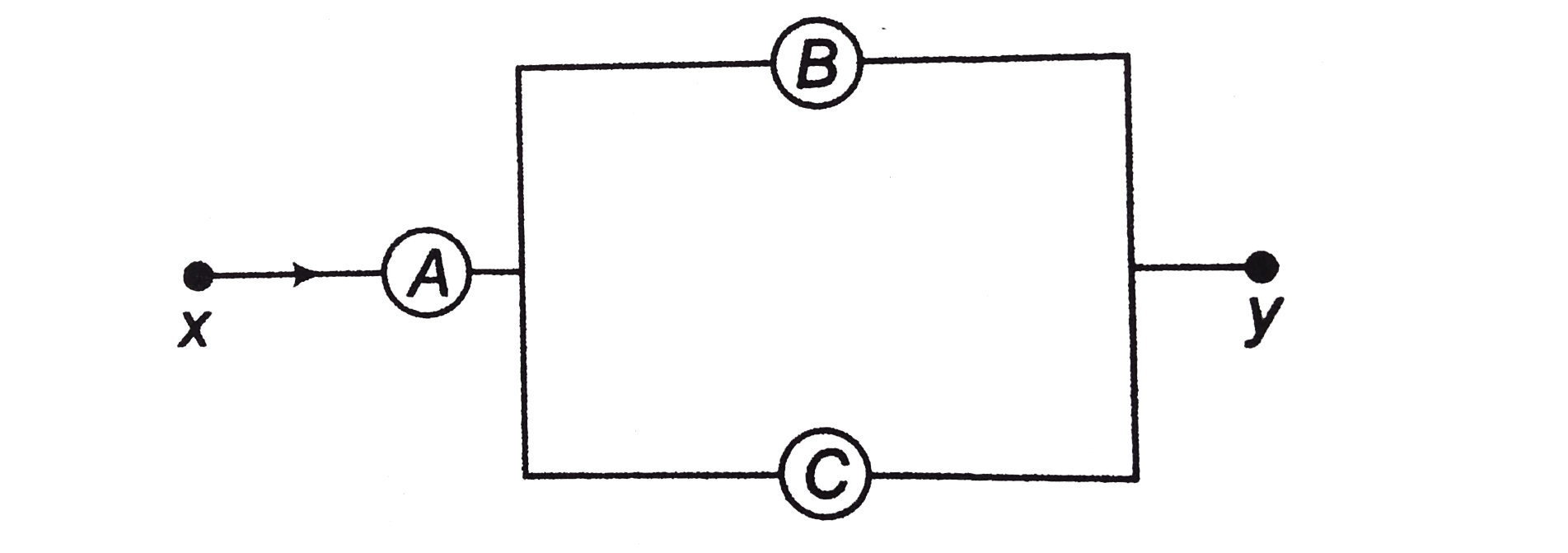
View SolutionAcross a metallic conductor of non-uniform cross-section a constant potential difference is applied. The quantity
View SolutionTwo metal wires of identical dimesnios are connected in series. If `sigma_(1)` and `sigma_(2)` are the conducties of the metal wires respectively, the effective conductivity of the combination is
View SolutionA circuit contains an ammeter, a battery of `30 V` and a resistance `40.8 ohm` all connected in series. If the ammeter has a coil of resistance `480 ohm` and a shunt of `20 ohm`, the reading in the ammeter will be
View SolutionA potentiometer wire of Length `L` and a resistance `r` are connected in series with a battery of e.m.f. `E_(0)` and a resistance `r_(1)`. An unknown e.m.f. `E` is balanced at a length `l` of the potentiometer wire. The e.m.f. `E` will be given by :
View SolutionThe resistance in the two arms of the meter bridge are `5 Omega` and `R Omega`, respectively. When the resistance `R` is shunted with an equal resistance, the new balance point is `1.6 l_(1)`.
The resistance `R` is

View SolutionA potentiometer circuit has been setup for finding. The internal resistance of a given cell. The main battery used a negligible internal resistance. The potentiometer wire itsefl is `4 m` long. When the resistance, `R`, connected across the given cell, has value of
(i) Infinity `9.5 Omega`,
(ii) the 'balancing length' , on the potentiometer wire are found to be `3 m` and `2.85 m`, respectively.
The value of internal resistance of the cell is
View SolutionIn a ammeter `0.2%` of main current passes through the galvanometer. If resistance of galvanometer is `G`, the resistance of ammeter will be
View SolutionA wire of resistance `4 Omega` is stretched to twice its original length. The resistance of stretched wire would be
View SolutionThe internal resistance of a `2.1 V` cell which gives a current `0.2 A` through a resistance of `10 Omega`
View SolutionThe resistance of the four arms `P, Q, R` and `S` in a Wheatstone's bridge are `10 ohm 30 ohm` and `90 ohm` rerspectively. The e.m.f. and internal resistance of the cell are `7 volt` and `5 ohm` respectively. If the galvanometer resistance is `50 ohm`, the current drawn for the cell will be
View SolutionA milli voltmeter of 25 milli volt range is to be converted into an ammeter of 25 ampere range. The value (in ohm) of necessary shunt will be
View SolutionIn the circuit shown the cells `A` and `B` have negligible resistance. For `V_(A) = 12 V, R_(1) = 500 Omega` and `R = 100 Omega`, the galvanometer `(G)` shows no deflection. The value of `V_(B)` is

View SolutionA current of `2 A` flows through a `2 Omega` resistor when connected across a battery. The same battery supplies a current of `0.5 A` when connected across a `9 Omega` resistor. The internal resistance of the battery is
View SolutionA potentiometer circuit is setup as shown. The potential gradient across the potentiometer wire is `k "volt"//cm` and the ammeter present in the circuit reads. `1.0 A` When two-way key is switched off. The balance point, when the key between the terminals (i) 1 and 2 (ii) 1 and 3, is plugged in, are found to be at lengths `l_(2) cm` and `l_(2) cm` respectively. The magnitudes, of the resistors `R` and `X`, in ohm, are then, equal, respectively, to

View SolutionA galvanometer has a coil of resistance `100 Omega` and gives a full-scale deflection for `30 mA` current. If it is to work as a voltmeter of `30 V` range, the resistance required to be added will be
View SolutionConsider the following two statements:
(A)Kirchhoff's junction law follows from conservation of charge.
(B)Kirchhoff's loop law follows from conservative nature of electirc field .
View SolutionThe mean free path of electrons in a metal is `4 xx 10^(-8)m` The electric field which can give on an average `2eV` energy to an electron in the metal will be in the units `V//m`
View SolutionSee the electrical circuit shown in this figure. Which of the following equations is the correct equation for it ?

View SolutionA student measures the terminal potential difference `(V)` of a cell (of emf `epsilon` and internal resistance `r`) as a function of the current `(I)` flowing through it. The slope and intercept of the graph between `V` and `I`, then respectively, equal
View SolutionA wire of resistance `12 Omega m^(-1)` is bent to from a complete circle of radius `10 cm`. The resistance between its two diametrically opposite points, `A` and `B` as shown in the figure, is
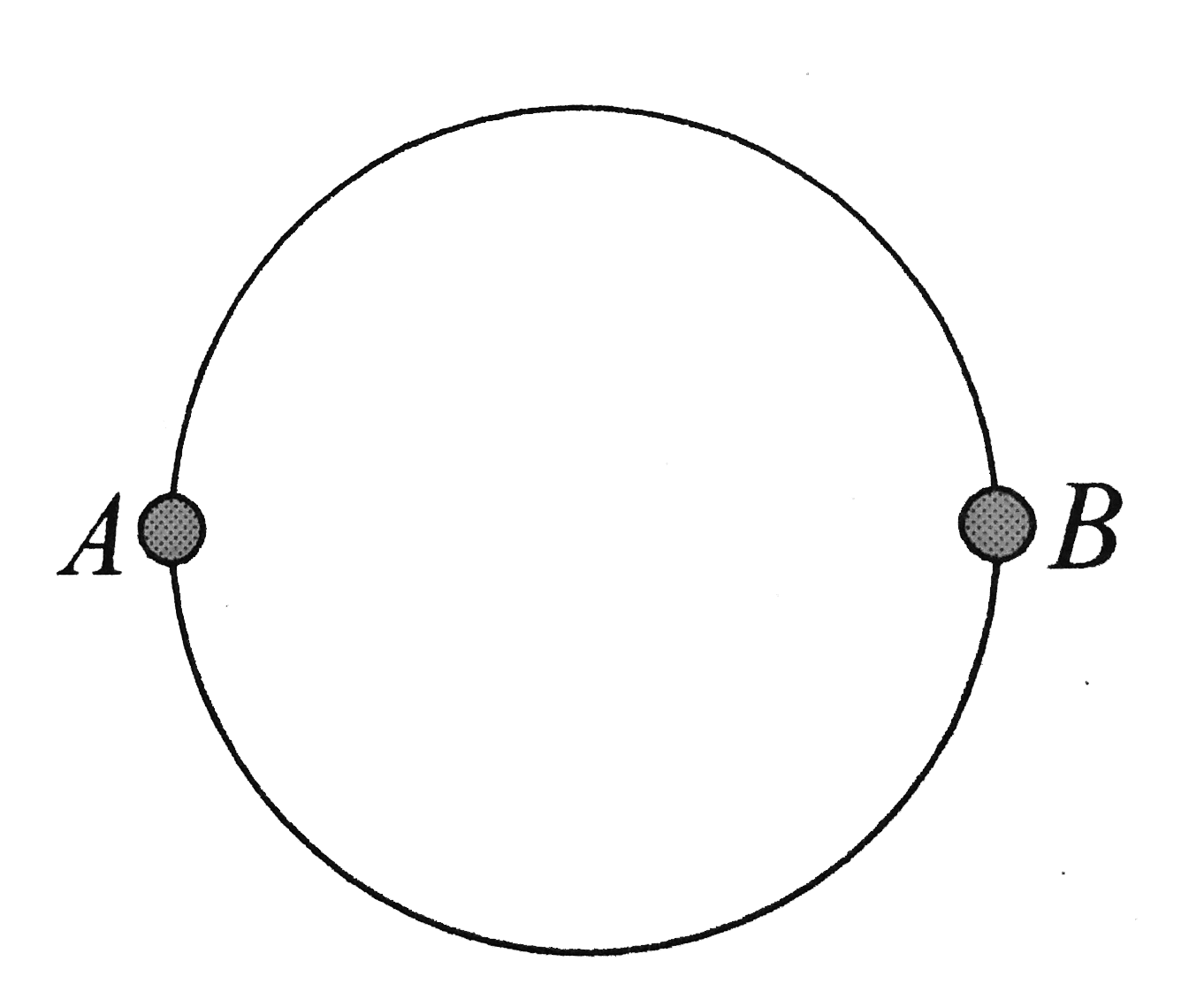
View SolutionIn the circuit shown, the current through the `4 Omega` resistors is `1 amp` when the points `P` and `M` are connected to a `dc` voltage source. The potential difference between the points `M` and `N` is.
 .
.
View SolutionA cell can be balanced against `110 cm` and `100 cm` of potentiometer wire, respectively with and without being short circuited through a resistance of `10 Omega`. Its internal resistance is
View SolutionA wire of a certain material is stretched slowly by ten percent. Its new resistance and specific resistance become respectively.
View SolutionThree resistance `P, Q, R` each of `2 Omega` and an unknown resistance `S` from the four amrs of a Wheatstone's bridge circuit. When a resistance of `6 Omega` is connected in parallel to `S` the bridge gets balanced. What is the value of `S` ?
View SolutionThe resistance of an ammeter is `13 Omega` and its scale is graduated for a current upto `100 A`. After an additional shunt has been connected to this ammeter it becomes possible to measure currents upto `750 A` by this meter. The value of shunt resistance is
View SolutionTwo cells, having the same emf, are connected in series through an external resistance `R`. Cells have internal resistance `r_(1)` and `r_(2) (r_(1) gt r_(2))` respectively. When the circuit is closed, the potentail difference across the first cell is zero the value of `R` is
View SolutionIn the circuit of a condacting wire is connected between point A and B the current is this wire will

View SolutionWhen a wire of uniform cross-section `a`, length `I` and resistance `R` is bent into a complete circle, resistance between two of diametrically opposite points will be
View SolutionTwo batteries, one of emf 18V and internal resistance `2Omega` and the other of emf 12 and internal resistance `1Omega` , are connected as shown. The voltmeter V will record a reading of
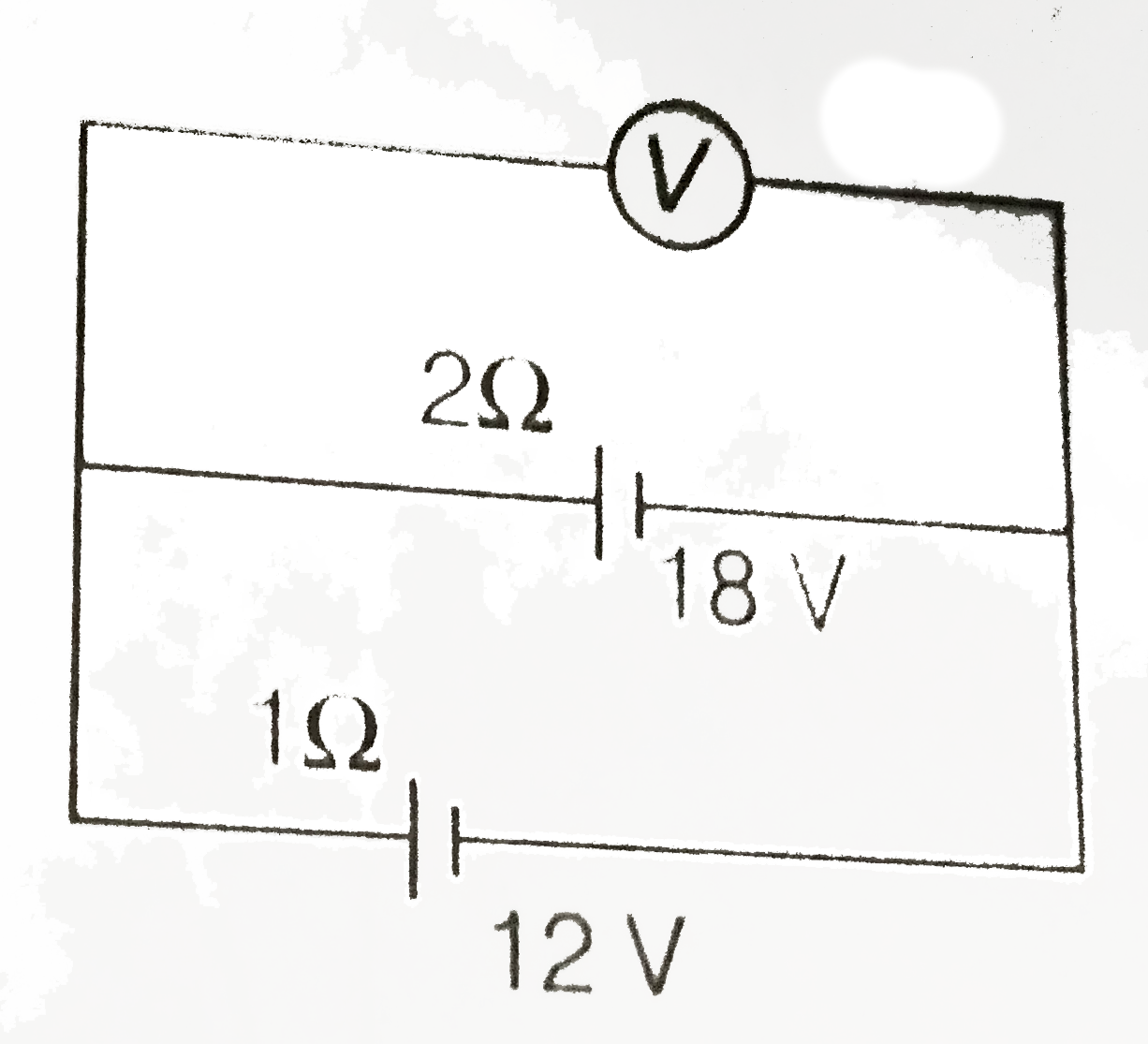
View SolutionA battery of 6 volts is connected ot the termainals of a three meter long wire of uniform thickness and resistance of the order of `100 Omega`. The difference of potential between two points separated by `50 cm` on the wire will
View SolutionFive equal resistances each of resistance `R` are connected as shown in the figure. A battery of `V` volts is connected between `A` and `B`. The current flowing in `AFCEB` will be

View SolutionResistance `n`, each of `r ohm`, when connected in parallel give an equivalent resistance of `R ohm`. If these resistances were connected series, the combination would have a resistance in ohm, equal to
View SolutionThe electric resistance of a certain wire of iron is `R`. If its length and radius are both doubled, then
View SolutionA battery is charged at a potential fo 15 V for 8 h when the current folwing is 10A. The battery on discharge supplies a current of 5A fo 15h . The mean terminal voltage during discharge is 14V. The watt-hour efficiency of the battery is
View SolutionIn a Wheatstone's bridge all the four arms have equal resistance `R`. If the resistance of the galvanometer arm is also `R`, the equivalent resistance of the combination as seen by the battery is
View SolutionFor a cell, the terminal potential difference is `2.2 V`, when circuit is open and reduces to `1.8 V `. When cell is connected to a resistance `R=5Omega`, the internal resistance of cell `(R)` is
View SolutionThe specific resistance of a conductor increases with:
View SolutionResistivity of potentiometer wire is `10^(-7)` ohm metre and its area of cross-section is `10^(-6)m^2`. When a current `l=0.1A` flows through the wire, its potential gradient is:
View SolutionIn a wheatstone bridge resistance of each of the four sides is `10Omega`. If the resistance of the galvanometer is also `10Omega` , then effective resistance of the bridge will be
View SolutionA cell has an emf 1.5V. When connected across an external resistance of `2Omega`, the terminal potential difference falls to 1.0V. The internal resistance of the cell is:
View SolutionPotentiometer measures the potential difference more accurately than a voltmeter, because
View SolutionA bridge circuit is shown in figure. The equivalent resistance between A and B will be
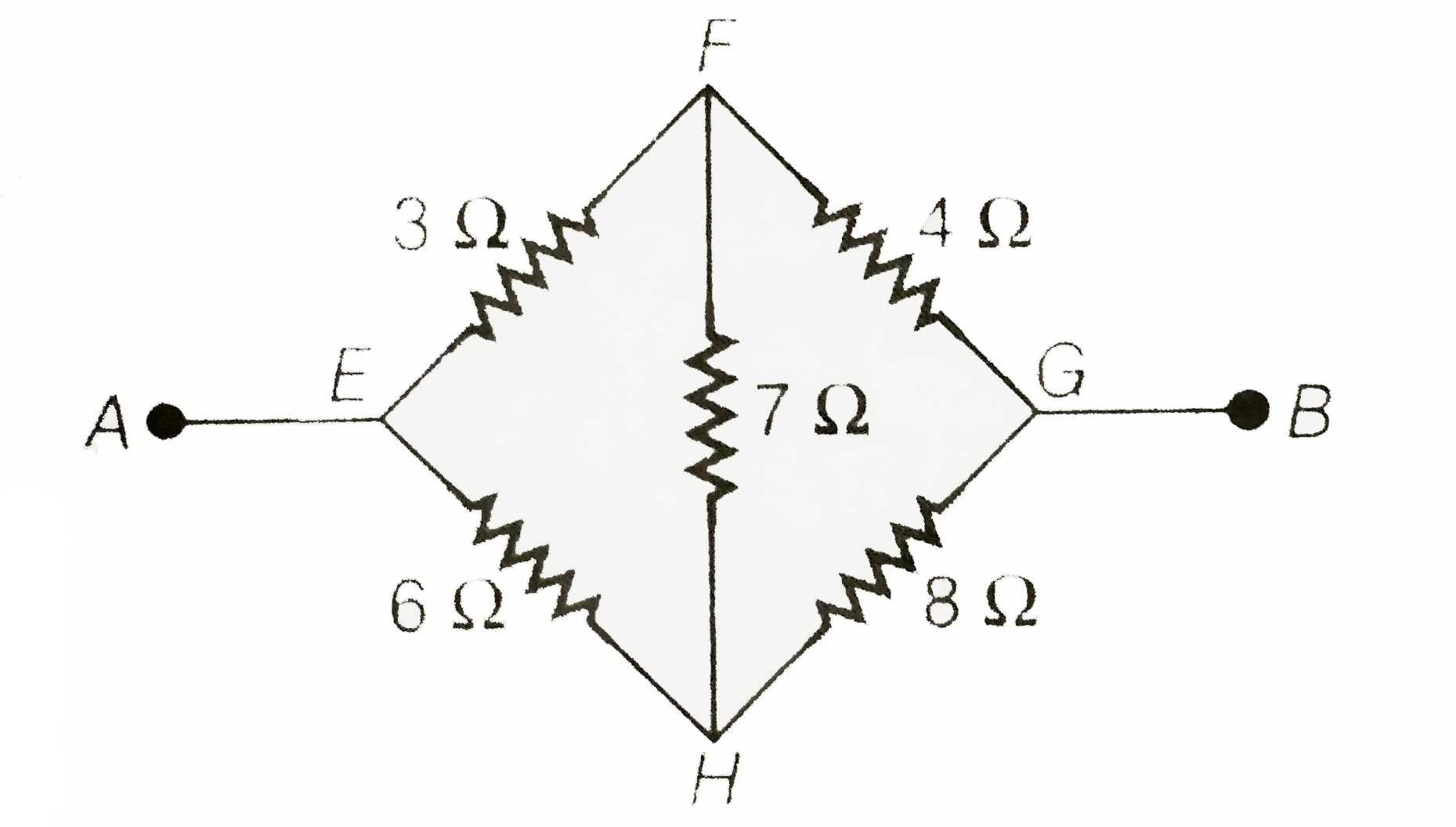
View SolutionA potentiometer consists of a wire of length 4 m and resistance `10Omega`. It is connected to a cell of emf 2V.The potential gradient of the wire is
View SolutionIn meter bridge , the balancing length from left is found to be 20 cm when standard connected of `1 Omega` is in right gap . The value of unknown resistance is
View SolutionThe resistance of a discharge tube is
View SolutionThe current (i) in the given circuit is

View SolutionFrom the given between current I and voltage V shown in figure , indentify the portion corresponding to negative resistance

View SolutionThere are three copper wires of length and cross-sectional area (L,A),(2L,A/2)(L/2,2A). In which case in the resistance minimum?
View SolutionThe current in the following circuit is

View SolutionKirchhoff's first law i.e., `sum I = 0` at a junction is based on the law of conservation of
View SolutionWhat will be the equivalent resistance fo circuit shown in figure between two points A and D?

View SolutionA negligibly small current is passed through a wire of length 15 m and uniform cross-section `6.0 xx 10^(-7)Omega m^(2)`, and its resistance is measured to be `5.0 Omega`. What is the resistivity of the material at the temperature of the experiment ?
View SolutionIf the resistance of a conductor is `5 Omega` at `50^(@)C` and `7Omega` at `100^(@)C` then the mean temperature coefficient of resistance of the material is
View SolutionIf a wire of resistance `R` is melted and recasted in to half of its length, then the new resistance of the wire will be
View SolutionTwo wire of the same meta have same length, but their cross-sections are in the rati `3:1` . They are joined in series. The resistance of thicker wire is `10Omega` . The total resistance of the combination will be
View SolutionIn the circuit of figure, the current in `4Omega` resistance is 1.2A , what is the potential difference between B and C?

View SolutionCurrent through `3Omega` resistor is 0.8A, then potential drop through `4Omega` resistor is

View SolutionThree resistance each of `4Omega` are connected to form a triangle. The resistance between any two terminals is
View SolutionKirchhoff's first law of electricity follows.
View SolutionThe velocity of charge carries of current (about 1 A) in a metal under normal conditions is of the order of
View SolutionYou are given several identical resistors each of value `10Omega` and each capable of carrying a maximum current of 1 A. It is required to make a suitable combination of these to resistances to produce a resistance of `5Omega` which can carry a current of 4 A. The minimum number of resistors required for this job is
View SolutionIn the network shown in figure each resistance is `1Omega` . The effective resistance between A and B is
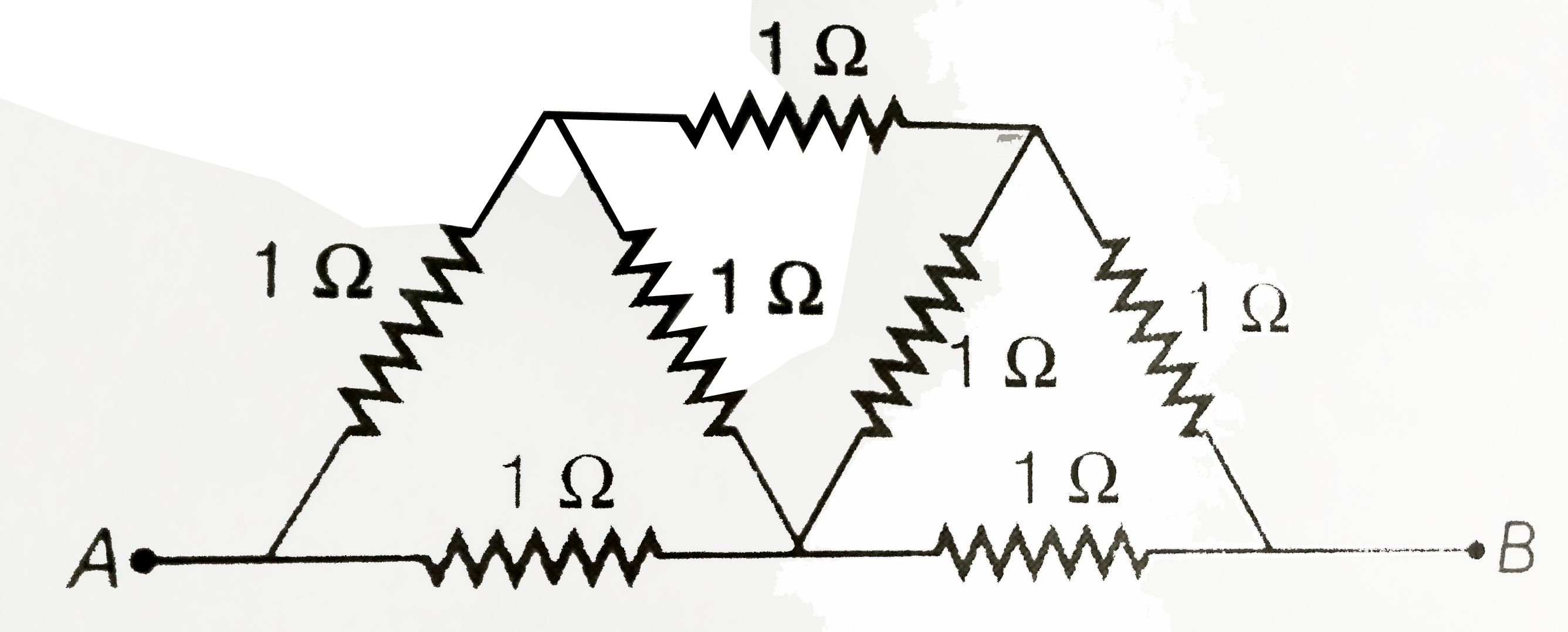
View Solutionn equal resistors are first connected in series and then connected in parallel. What is the ratio of the maximum to the minimum resistance ?
View SolutionThe massses of the three wires of copper are in the ratio 1 : 3 : 5. And their lengths are in th ratio 5 : 3 : 1. the ratio of their electrical resistance is
View SolutionTwo batteries of e.m.f. `4V` and `8V` with internal resistances `1 Omega` and `2 Omega` are connected in a circuit with a resistance of `9 Omega` as shown in figure. The current and potential difference between the points `P` and `Q`

View Solution
All Questions questions and complete solutions for chapter CURRENT ELECTRICITY of NEET PREVIOUS YEAR (YEARWISE + CHAPTERWISE) of Class 12